
Thank you for visiting HOJO website. If you have any enquiry, please feel free to get in touch with us at
▼ Akira Hojo
▼ Hojo Newsletter
▼ HOJO FACEBOOK





HOME > Oolong Tea > Li Shan Cha
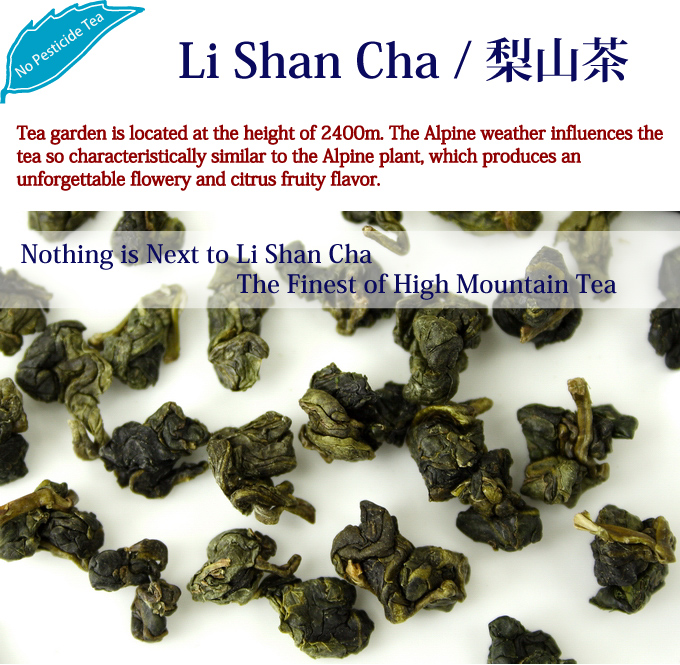
Refreshing and Sweet, yet ElegantThe type of flavor is similar to the citrus fruit. It gives a very refreshing flavor accompanied by a sweet flowery flavor. Many customers compliment its flavor the moment they drink this tea. Its citrus fruity flavor has similarity to citrus fruits. |
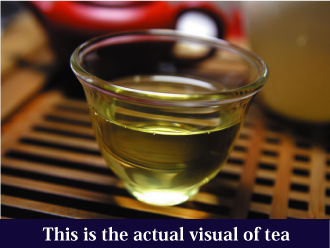
|
Taiwan has many high mountains and some mountains are even higher than Li Shan. Nevertheless, Li Sha Cha is the top of all those teas. The identical flavor of Li Shan Cha is created by the specific weather and soil condition of Li Shan and it is totally different from other high mountain tea.
Once our Li Shan Cha is brewed, a table spoon of tea leaves expands to the maximum volume of the tea pot it is in. If you look at tea leaves, it still maintains the original shape as it was plucked at the garden. It does not only maintain its shape, but it is also very soft and tender. Our Li shan Cha is obtained from tea garden located very up on the mountain and therefore the leaves are thick, but very soft and elastic.
This tea does not give any bitterness and astringency, but a very smooth mouth feel and is sweet. This tea is also suitable for those who suffer from gastric ailments.
You can continue brewing our Li Shan Cha until the 7th brewing. Use a tablespoon (5g) of tea leaves, you will be able to brew up to 1 liter of tea.
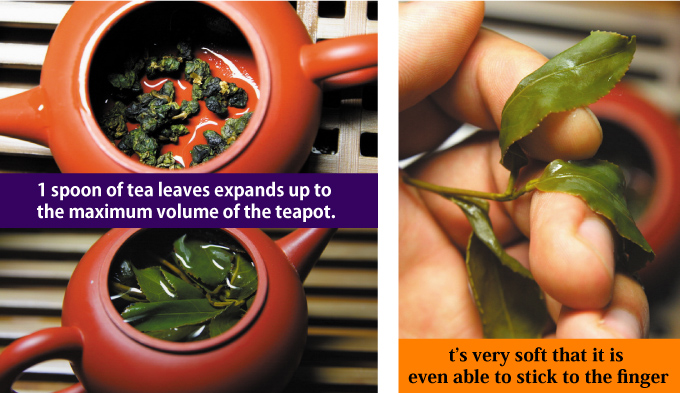
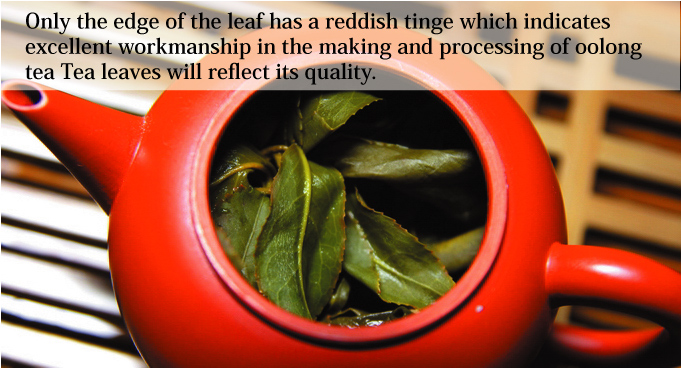
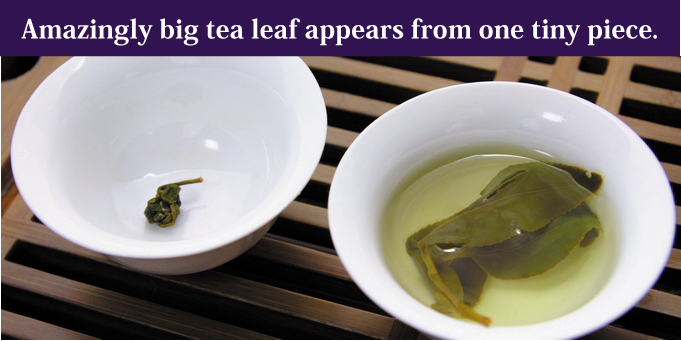

In Taiwan, Li Shan Cha can be considered as the King of High Mountain Tea. People often describe this tea as "There is nothing next to Li Shan Cha". The quality of Li Shan Cha is outstanding as people in Taiwan appreciate this tea. However the increasing demand for this tea in Taiwan also create a lot of fake Li Shan Cha which is not grown at Li Shan, but at other mountain, or sometimes at the lower levels of Li Shan which do not produce high quality Li Shan. The genuine Li Shan Cha should be from the tea garden located higher than 2000m and carefully produced tea gives a very strong citrus flavor which is powerful enough to impress even a beginner.
Tea that is grown at high mountains are called high mountain tea in Taiwan. Presently, high mountain tea is becoming very popular and more and more mountain areas are being developed into tea gardens for a more vigorous and a larger volume of tea cultivation. It is common to find tea cultivation at the height of 2000m but our Li Shan Cha is produced at even as high as 2400m. Generally the weather, ecology and environment of Taiwan High Mountain area resembles the mountain area at Darjeeling.
Li Shan Cha is produced at the Li Shan which is located in the center of Taiwan. Li Shan is a mountain that is 1500−2400m. Considering the altitude of the Li Shan Tea garden, it is not the highest. It is known that altitude alone does not contribute to the quality of tea but most importantly, the soil condition and the particularly suitable environment which can only be found at Li Shan is the key factor in producing the delicious and identical flavor of Li Shan Cha.

Up on High Mountains, tea garden gets appropriate sun shine only in the morning. In the afternoon thereon, the tea garden is completely covered by a thick fog which is the highly ideal condition to cultivate high mountain teas. Less sun shine produces less bitter substance and therefore the tea leaves are amazingly sweet. In addition, the temperature between day time and night time is significant on account of the alpine weather which is also excellent for high mountain teas. In the morning, tea gets very strong sun shine that produces nutrition and other substances. At night, the temperature drops tremendously and tea leaves stop metabolism and preserve those substances produced in morning. On the contrary, if the temperature doesn't decrease at night, tea will continue its metabolism rate and keep spending the substances which is very crucial in determining the taste and quality of the tea; subsequently tea has less taste.
However these are not only the reasons in creating specific character of Li Shan Cha. The unique citrus fruity flavor could be contributed by other factors as well. In fact, the identical flavor of Li Shan Cha is never seen in other high mountain tea regardless of the altitude.
It is said that tea will produce a very sweet fruity fragrance when if it undergoes a stressful environment. We found the same phenomenon in Darjeeling teas. As for Li Shan Cha, we assume that the soil condition, insects or a unique environment of Li Shan area contribute to its original flavor.
The cultivars for HOJO's Li Shan Cha is Qing-Xin Oolong (青心烏龍種). This is the genuine cultivars traditionally used for Dong Ding Oolong that gives very refreshing taste.
Tea grown at organic gardens appear to be less active and has less productivity as tea gets less nutrition and pesticide as compared to the ordinary tea garden. As the identical characteristics, tea leaf turns into a yellow color and sweetness in flavor and taste is outstanding.
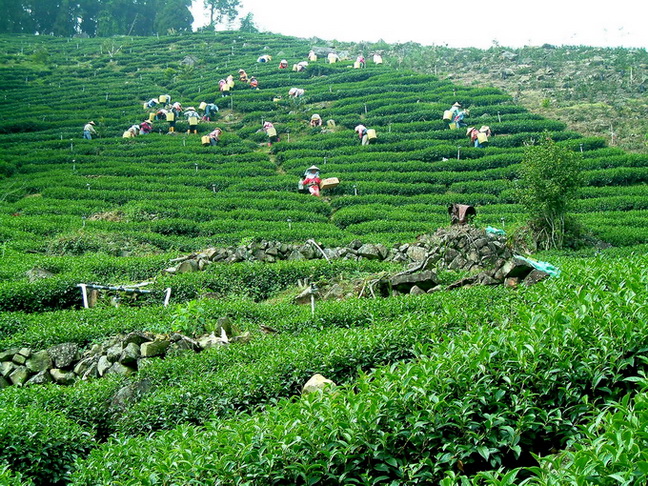
Plucking is carried out manually. 3 to 4 leaves including a bud is carefully plucked by hand. Plucking is carried out 2 times in spring and winter. Usually the amount of rain prior to the plucking seaso will affects the quality. We select either tea depending on the condition of each year.
After plucking, tea leaves are spread over the ground under the natural sunshine. It is called Sunshine Withering. Usually clouded weather is ideal to grow this tea in order to avoid excess damage on tea leaves. If the sunny weather continues, a black cloth is used to cover the tea leaves to block out the harsh rays of sunshine. With sunshine withering, moisture inside the tea leaf gets evaporated and fermentation is moderately triggered. The tea leaf will gradually start releasing a refreshing aroma.
The method of fermentation for oolong tea is completely different from that of black tea. After the sunshine withering is completed, tea leaves are conveyed into the factory and spread over a sheet. If tea leaves are rich in moisture, they are spread into a thin layer in order to increase the evaporation process. The tea leaves are then tossed onto a bamboo tray. This agitation and tossing, causes friction which in turn causes the tea leaves to start fermentation. The tray is then placed on a rack and these processes are repeated over and over again. This is what is called fermentation. Tea leaves gets oxidation mediated by the oxidation enzyme when the tea leaves get bruised.
Once entering the fermentation room, you might get surprised with its fragrance. You feel as if you are in a flower garden. Subsequently tea leaves are rotated in a bamboo drum. The tea leaves are lifted and dropped several times. Gradually the edge of tea leaves get damaged and further fermentation takes place. Tea leaves are again spread over the bamboo tray and the same process is repeated over and over again.
Once tea leaves get sufficient fermentation, it starts generating a flowery fragrance. Tea that is processed by a fine tea master is easily distinguishable. The original shape is maintained without any damage done to the tea leaves and only the edge of tea leaves are found to be red in color. This indicates that the tea leaves were successfully semi-fermented and the quality is far different from the tea leaves which have a reddish appearance at the center part of the leaf. Once the tea master finds that fermentation is sufficiently achieved, the tea is then sent for heat treatment in order to arrest further fermentation process. If this is not carried out swiftly, the tea leaves will keep on fermenting and it will finally turn into black tea.
The number of rotation and timing of fermentation is judged based on the moisture content, flavor and color. This decision requires top-notch experienced tea technicians which affects the quality of tea tremendously. All technicians follow the instruction of a tea master. In order to get good quality tea, we need to pick out an excellent tea master.
At this stage, tea is fermented and giving an identical character of Dong Ding Oolong. However tea leave has not been damaged or bruised except for its edge. Without physical damage on tea leaf, it is difficult to "brew". On the other hand, conducting the rolling process as black tea that tea leaf is twisted tautly under the strong pressure, tea leaf will be over damaged and get astringent and harsh in taste. In addition, excessive damage of leaf will expose constituent to the oxygen and cause unwanted oxidation that will also affect to the taste and flavor. Therefore the very unique rolling process called "Bag rolling" is used for oolong tea. Literary tea leaf is wrapped in cloth and rolled. Therefore, tea leaves are twisted just right with the right amount of pressure applied.
While the tea leaves are still warm and soft, it is quickly wrapped in cloth bag. About 10-20kg of tea leaf is wrapped and it is made into the size of about a basket ball. Then the end of cloth is mechanically twisted by machine in order to squeeze it into a very solid ball. Finally it becomes as solid as a stone ball and as a result the tea leaves are compressed very tightly.
Then, the cloth ball is clamped between disks at the top and bottom. The top disk does not move while the bottom disk rotate and tea gets further pressure through the motion. After the rolling process is conducted for a while, the bag is opened and the tea leaves are taken out and reheated again in a rotating drum. This is necessary as once the tea leaves cool down, it becomes crispy and easily crushed. This series of processes are repeated several times until it is well rolled.
The tea leaves are gradually tighten and become round in shape. High grade tea is usually very solid and it appears to be dark and shiny as the juice of the tea leaf is squeezed and hardens on the surface of the leaf.
The same sequence is repeated over and over again. The parameter is varied depending on the condition of leaf such as moisture content. It is important to feel the condition of tea leaf and apply the suitable method of process which is judge expertly by the tea master.
After this rolling process is completed, the tea leaves are dried and this will reduce the moisture content down to 5%.
The easiest way to judge between good tea and less good tea is that you brew tea a few times and wait till it cools down, then take a sniff of the brewed tea leaves. The brewed leaf is always very honest in its quality. The brewed leaf of good quality is always very fresh and fragrant.
Dark Green, Shining and is consistently dark green. You can detect a citrus flavor over the dry tea leaf. The lower grade tea is not consistent in terms of shape and color.
Transparence and yellow in color. The higher grade teas can be brewed up to 7-8 times, while lower grade teas lasts only 2-3 brewing.
Tea leaf is just like as it was plucked. Less damaged and the tea leaf is green in color except for the edge that is fermented is reddish in color. The leaf is thick, yet very elastic and soft. Good tea leaf maintains a strong fragrance of Li Shan Cha no matter how many times it is brewed. In particular, it is effective to let the leaves cool down and take a sniff to determine the smell. Low grade tea leaves are not consistent in terms of its shape, color and elasticity, and also containing many broken tea leaves. When you touch, it is not soft, but stiff.
Go to further information about suitable water for brewing tea >>
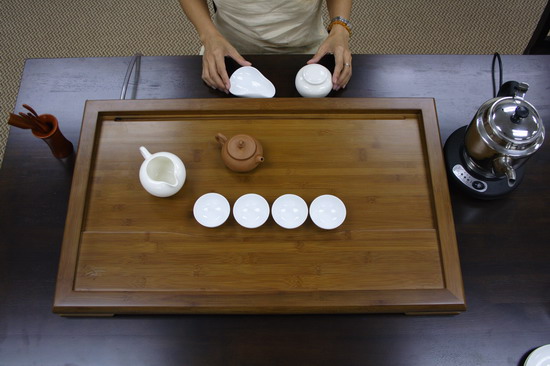
Arrange tea ware.
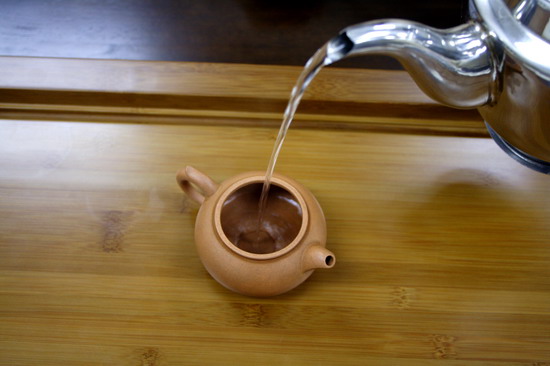
Pour boiling water into the tea pot and fill up to 70%. This is to heat up the tea pot.
Go to further information about suitable water for brewing tea >>
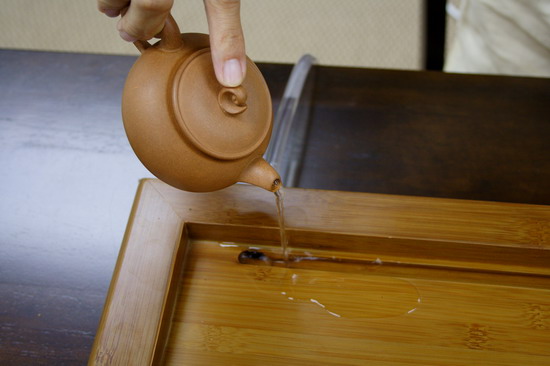
After 20 seconds, remove hot water from the warmed tea pot.
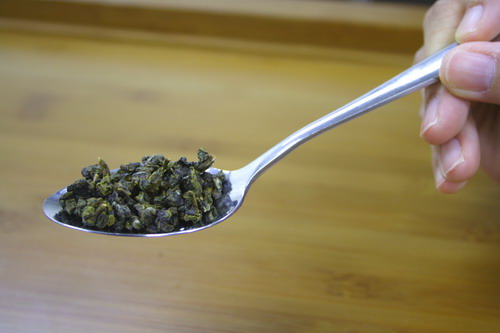
Usually 1g is equivalent to 25〜50ml of water. For the small tea pot for 1 to 2 persons, 3-4g is sufficient.
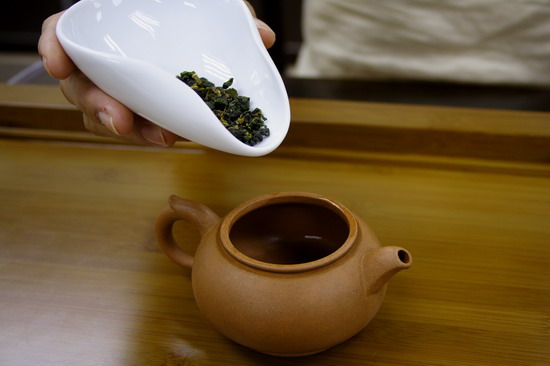
The tea pot in the photo is about 200ml and therefore we take tea leaf around 5g.
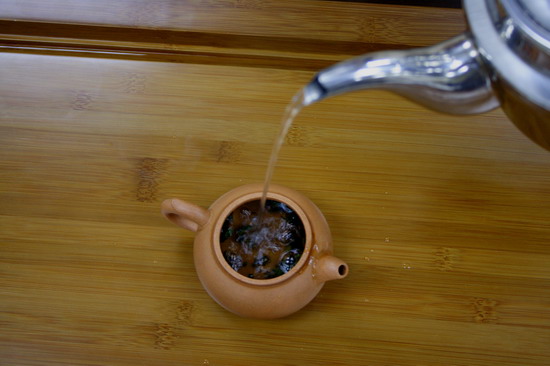
Pour boiling water onto tea leaf up to 50% of the volume of tea pot. It is not for washing purpose, but to heat up the tea leaf and open them up.
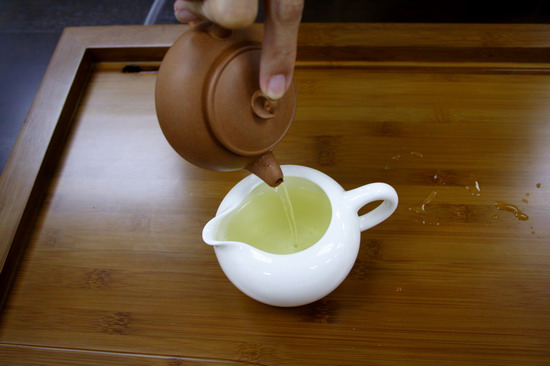
Once again pours off hot water within 10 seconds. Usually we recommend 7 seconds.
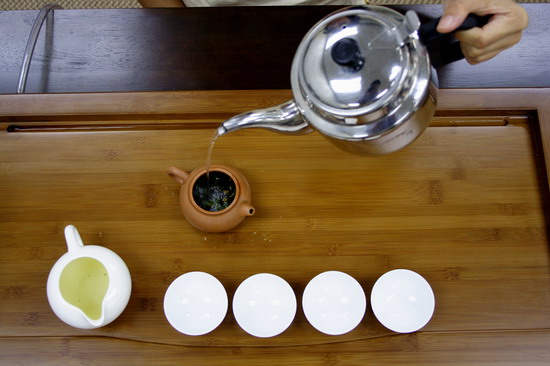
Pour boiling water into tea pot up to 90%.
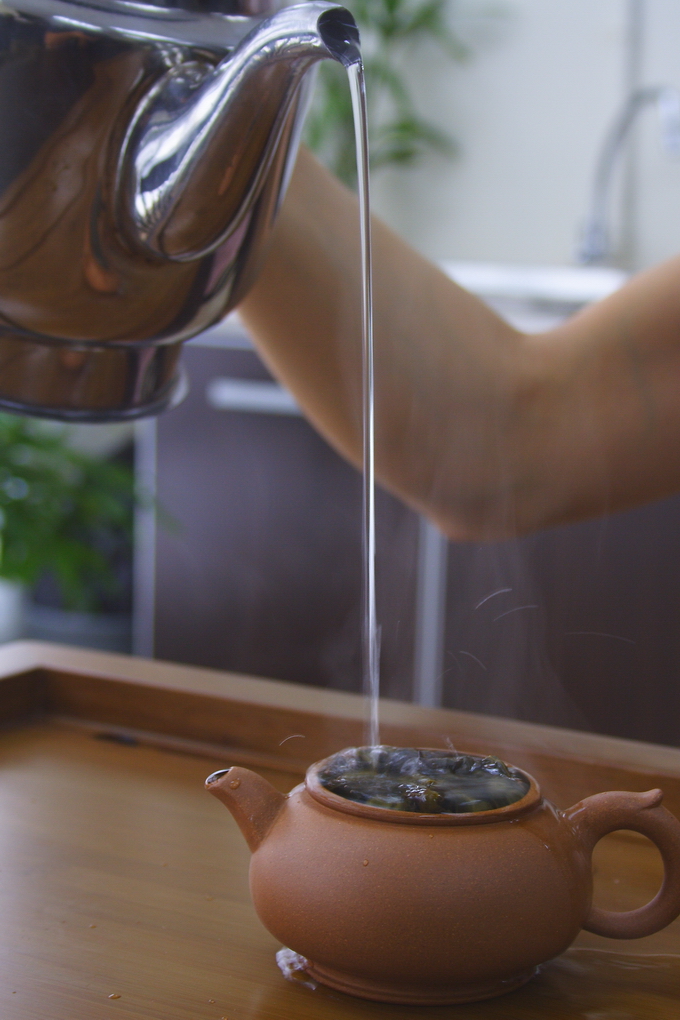
You can feel the aroma through the upcoming steam.

Gently place the lid and leave it for 55 seconds. For second brewing leave it for 45 seconds, follow by 55 seconds for the third brewing.
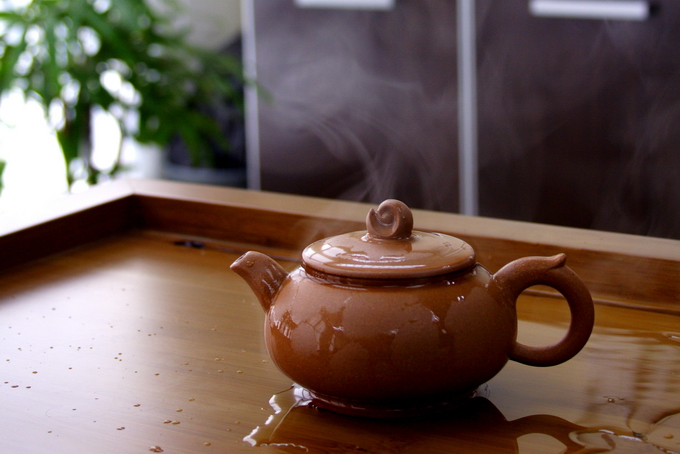
In China, they pour boiling water over the cap in order to keep the tea pot warm. But this method never used in Taiwan as they think tea pot is hot enough.
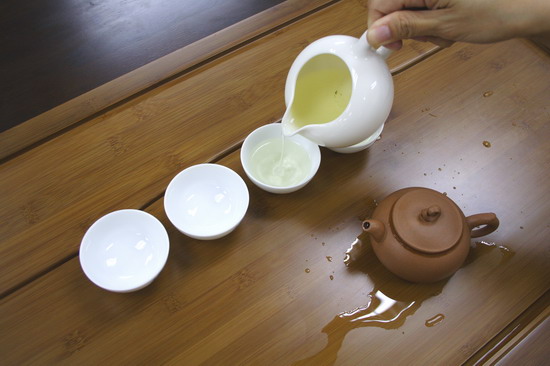
While waiting for brewing, pour hot water from pitcher into the tea cups in order to warm them up. But this is not practiced in Taiwan as they believe there is no need to warm up the tea cup.
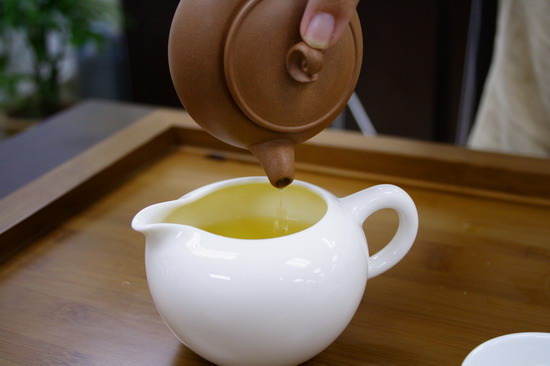
Pour tea into pitcher completely. It is important to enjoy the following brewing.
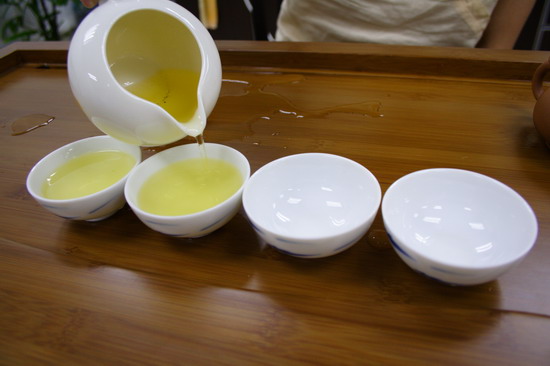
Pour tea from the right end which is supposed to be served for the guest.
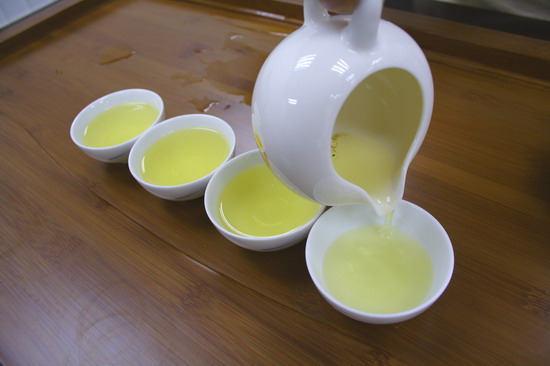
The last one is meant for the host.
Once a bag of tea is opened, please finish it within 3 months if you wish to enjoy its freshness. From the medical point of view, it is safe to consume the tea even if it is kept for a few years. However the freshness disappears if it is kept for too long. Tea must be tightly sealed before it is kept. Tea should be kept in ambient and dry conditions such as in the living room, but it must be completely away from humidity. Tea should not be kept in the kitchen as the environment is very humid. Avoid enclosed area such as inside the cupboard or drawer as these places are damp. Also avoid opening the bag of tea in humid atmosphere. It is recommended to open the bag during a sunny day or under air-conditioned atmosphere. Once tea leaves absorb moisture, deterioration of tea will be triggered within a few days. Tea will then give an astringent taste, sometime it tastes sour. The fresh aroma also becomes weaker.
The quality of tea lasts longer if it is kept in the fridge. However we strongly recommend you not to keep tea in the fridge. When tea is withdrawn from the fridge, there is usually condensation. Once tea is exposed to moisture during condensation, the quality will deteriorate within a few days. The higher moisture content in the tea leaves will trigger oxidation and it will completely destroy the quality of tea.
Here’s one frequently asked question: what happens if bag is sealed using tape or tea is packed in zipper bag and kept inside the fridge?
For your information, these simple sealing methods are not sufficient. When the bag is withdrawn from the fridge, it is cold inside the bag and therefore causes negative pressure. Air will be drawn from outside and condensation will occur. In addition, if the bag is taken in and out from the fridge very often, this will cause heat stress to the tea leaves as temperature is increased and decreased very frequently. If tea is kept in the fridge, when it is withdrawn from the fridge, it is necessary to leave it in ambient atmosphere for more than 24 hours in order to warm up the tea leaves. Based on our experience, 12 hours is not long enough. We may think tea is warmed up, but inside the bag, the tea leaves are still cold due to insulation effect.

Please feel free to send us e-mail for enquiry at:

 |
We accept various kinds of credit card through Paypal.
Only if customer prefer other option of payment, we suggest "Bank Transfer".
Various choice of shipping method
EMS, SAL, Small Packet, Small Packet (SAL) Yamato Express and Surface
For shipping tea, we usually suggest small air parcel, the estimated shipping cost of tea in 100g (with wrapping material ) is
Small Parcel
USA JPY 600, EU JPY600 and Asia JPY470
Small Packet (SAL)
USA JPY380, EU JPY380 and Asia JPY320
The shipping fee to oversea by small air parcel happens to be even cheaper than domestic shipping fee in Japan.
For your information, some countries, EU in particular imposes custom duty. We need buyer to bare the duty. We are sorry, but we cannot change the amount on the invoice, and we do not mark any packages as gifts. We will strictly follow the custom regulation.